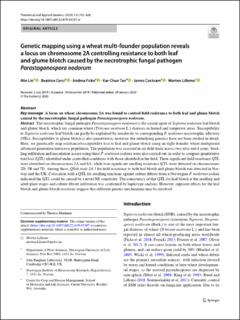| dc.contributor.author | Lin, Min | |
| dc.contributor.author | Corsi, Beatrice | |
| dc.contributor.author | Ficke, Andrea | |
| dc.contributor.author | Tan, Kar-Chun | |
| dc.contributor.author | Cockram, James | |
| dc.contributor.author | Lillemo, Morten | |
| dc.date.accessioned | 2021-11-02T06:30:34Z | |
| dc.date.available | 2021-11-02T06:30:34Z | |
| dc.date.created | 2020-08-27T16:53:52Z | |
| dc.date.issued | 2020 | |
| dc.identifier.citation | Theoretical and Applied Genetics. 2020, 133 (3), 785-808. | |
| dc.identifier.issn | 0040-5752 | |
| dc.identifier.uri | https://hdl.handle.net/11250/2827086 | |
| dc.description.abstract | Key message A locus on wheat chromosome 2A was found to control feld resistance to both leaf and glume blotch caused by the necrotrophic fungal pathogen Parastagonospora nodorum. Abstract The necrotrophic fungal pathogen Parastagonospora nodorum is the causal agent of Septoria nodorum leaf blotch and glume blotch, which are common wheat (Triticum aestivum L.) diseases in humid and temperate areas. Susceptibility to Septoria nodorum leaf blotch can partly be explained by sensitivity to corresponding P. nodorum necrotrophic efectors (NEs). Susceptibility to glume blotch is also quantitative; however, the underlying genetics have not been studied in detail. Here, we genetically map resistance/susceptibility loci to leaf and glume blotch using an eight-founder wheat multiparent advanced generation intercross population. The population was assessed in six feld trials across two sites and 4 years. Seedling infltration and inoculation assays using three P. nodorum isolates were also carried out, in order to compare quantitative trait loci (QTL) identifed under controlled conditions with those identifed in the feld. Three signifcant feld resistance QTL were identifed on chromosomes 2A and 6A, while four signifcant seedling resistance QTL were detected on chromosomes 2D, 5B and 7D. Among these, QSnb.niab-2A.3 for feld resistance to both leaf blotch and glume blotch was detected in Norway and the UK. Colocation with a QTL for seedling reactions against culture fltrate from a Norwegian P. nodorum isolate indicated the QTL could be caused by a novel NE sensitivity. The consistency of this QTL for leaf blotch at the seedling and adult plant stages and culture fltrate infltration was confrmed by haplotype analysis. However, opposite efects for the leaf blotch and glume blotch reactions suggest that diferent genetic mechanisms may be involved. | |
| dc.language.iso | eng | |
| dc.title | Genetic mapping using a wheat multi-founder population reveals a locus on chromosome 2A controlling resistance to both leaf and glume blotch caused by the necrotrophic fungal pathogen Parastagonospora nodorum | |
| dc.type | Peer reviewed | |
| dc.type | Journal article | |
| dc.description.version | publishedVersion | |
| dc.source.pagenumber | 785-808 | |
| dc.source.volume | 133 | |
| dc.source.journal | Theoretical and Applied Genetics | |
| dc.source.issue | 3 | |
| dc.identifier.doi | 10.1007/s00122-019-03507-w | |
| dc.identifier.cristin | 1825617 | |
| dc.relation.project | Norges forskningsråd: 251894 | |
| cristin.ispublished | true | |
| cristin.fulltext | original | |
| cristin.qualitycode | 2 | |
